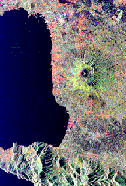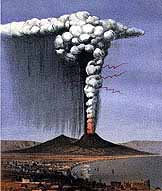
 Plinian (or Vesuvian) eruptions typify the
well-known historic eruptions that produce powerful convecting
plumes of ash ascending up to 45 kilometers into the stratosphere.
These explosive eruption types are named after Pliny the
Younger, a Roman statesman who wrote a remarkably objective
account of the eruption of Italy's Mt.
Vesuvius (left) in 79 AD. Pliny's uncle, Caius Plinius
(Pliny the Elder), was a much respected naturalist and
Admiral in the Roman navy who died during the eruption. To properly
record the circumstances of his esteemed uncle's death, Pliny
the Younger wrote two letters to the historian Tactius
describing the Mt. Vesuvius eruption. The eruption killed thousands
of people and buried the Roman towns of Pompeii
and Herculaneum under huge volumes of tephra,
pyroclastic flows, and lahars. Pompeii laid buried for over
1700 years until it was rediscovered by accident during the excavation
of a water line. Uncovering the remains of Pompeii has not only
broadened our understanding of Plinian-type eruptions, but it
has also provided a unique understanding of the lives of ordinary
people during Roman times.
Plinian (or Vesuvian) eruptions typify the
well-known historic eruptions that produce powerful convecting
plumes of ash ascending up to 45 kilometers into the stratosphere.
These explosive eruption types are named after Pliny the
Younger, a Roman statesman who wrote a remarkably objective
account of the eruption of Italy's Mt.
Vesuvius (left) in 79 AD. Pliny's uncle, Caius Plinius
(Pliny the Elder), was a much respected naturalist and
Admiral in the Roman navy who died during the eruption. To properly
record the circumstances of his esteemed uncle's death, Pliny
the Younger wrote two letters to the historian Tactius
describing the Mt. Vesuvius eruption. The eruption killed thousands
of people and buried the Roman towns of Pompeii
and Herculaneum under huge volumes of tephra,
pyroclastic flows, and lahars. Pompeii laid buried for over
1700 years until it was rediscovered by accident during the excavation
of a water line. Uncovering the remains of Pompeii has not only
broadened our understanding of Plinian-type eruptions, but it
has also provided a unique understanding of the lives of ordinary
people during Roman times.
 |
Mt. Vesuvius has experienced numerous Plinian eruptions since the famous eruption in 79 AD. Many of these are depicted in paintings, lithographs, and engravings. The lithograph shown here is titled "The Eruption of Vesuvius as seen from Naples, October 1822" from V. Day & Son, in G. Poullet Scrope, Masson, 1864. It exemplifies a typical Plinian column with an umbrella-shaped head. |
These spectacularly explosive eruptions are associated with volatile-rich dacitic to rhyolitic lava, which typically erupts from stratovolcanoes. The duration these eruptions is highly variable, from hours to days. The longest eruptions appear to be associated with the most felsic volcanoes. Although Plinian eruptions typically invlove felsic magma, they can occasionally occur in fundamentally basaltic volcanoes where the magma chambers become differentiated and zoned to create a siliceous top. An example of this was the Hekla eruption (Iceland) of 1947-48. Over the past 800 years, Hekla has had a history of generating violent initial eruptions of pumice, lasting a few hours, followed by prolonged extrusion of basaltic lava from the lower part of the chamber.
Rather than producing the discrete explosions that are typical of Vulcanian and Strombolian eruptions, Plinian eruptions generate sustained eruptive columns. Although they differ markedly from nonexplosive Hawaiian eruptions, Plinian eruptions are similar to Hawaiian fire fountaining in that both of these eruption types generate sustained eruption plumes. In both, the eruption plumes are maintained because the growing bubbles rise at about the same rate as the magma moves up through the central vent system.
Plinian eruptions generate large eruptive columns that are powered upward partly by the thrust of expanding gases, and by convective forces with exit velocities of several hundred meters per second. Some reach heights of ~45 km. These eruptive columns produce widespread dispersals of tephra which cover large areas with an even thickness of pumice and ash (see pumice-fall deposits). The region of pyroclastic fall accumulation is generally asymmetric around the volcano as the eruptive column is carried in the direction of the prevailing wind, as shown here in this NASA image of the Klyuchevskaya eruption in 1994.
The regions surrounding Plinian eruptions are not only subject to large volumes of pumice airfall (from 0.5 to 50 km3), but they are also subject to the most dangerous types of volcanic phenomena: pyroclastic flows and lahars. The occasional collapse of the eruptive column will generate hot, pyroclastic flows that advance down the volcano flanks at hurricane-force speeds. In addition, large volumes of water are often generated by the melting of snow banks and alpine glaciers during the eruption. The mixing of this water with unconsolidated tephra can generate volcanic mudflows (lahars). These features have the consistency of wet concrete, yet they can advance down slopes at the same rate as a rapidly moving stream.
The human devastation associated with the Plinian eruption of Mt. Vesuvius in 79 AD is largely attributed to all of these volcanic phenomena. Pompeii was located to the southeast, on the downwind side of the volcano. Not only was it subjected to the destructive force of several pyroclastic flows, but it was also buried under a huge thickness of airfall tephra. Although the village of Herculaneum was also destroyed by the eruption, it was located west of the volcano, and was not subjected to the same volume of airfall tephra that buried Pompeii. Instead, Herculeaneum was largely buried by pyroclastic flows and massive lahars which advanced down the volcano's western flank.
For more information on the relationship of Plinian Eruptions to column height and explosiveness, see Explosivity and the Eruption Column.
 For a detailed description
on the dynamics of a Plinian eruption, see Eruption model . For a QuickTime movie of a Plinian-type
eruption, double-click the image shown here.
For a detailed description
on the dynamics of a Plinian eruption, see Eruption model . For a QuickTime movie of a Plinian-type
eruption, double-click the image shown here.